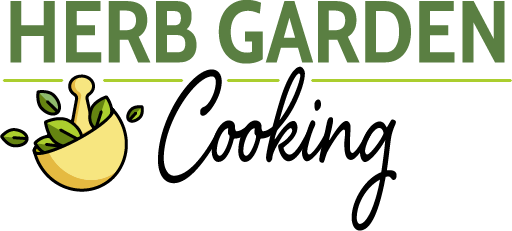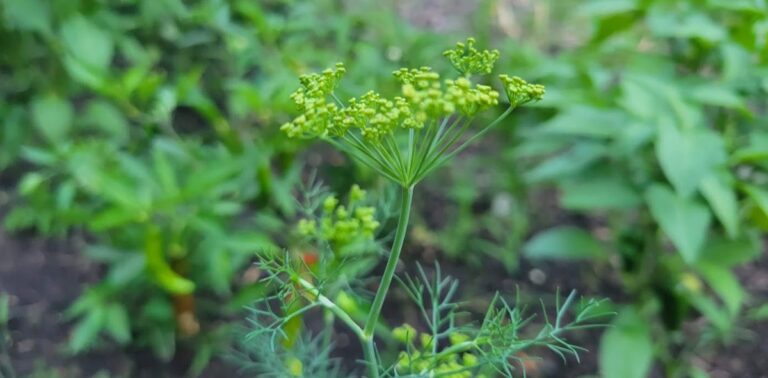This post may contain affiliate links which means I may receive a commission for purchases made through links. I only recommend products that I have personally used. As an Amazon Associate I earn from qualifying purchases. Learn more on my Private Policy page.
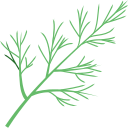
Dill stands out as a notable player in the world of companion planting. Known for its feathery fronds and culinary uses, dill also plays a critical role in supporting growth and deterring pests in many gardens. So, what grows well with dill?
Dill grows well with cucumbers, corn, lettuce, asparagus, and brassica family members like cabbage, broccoli, and kale due to its ability to attract beneficial garden insects, which deter common garden pests that attack these plants. Dill also grows well with herbs like basil and chervil.
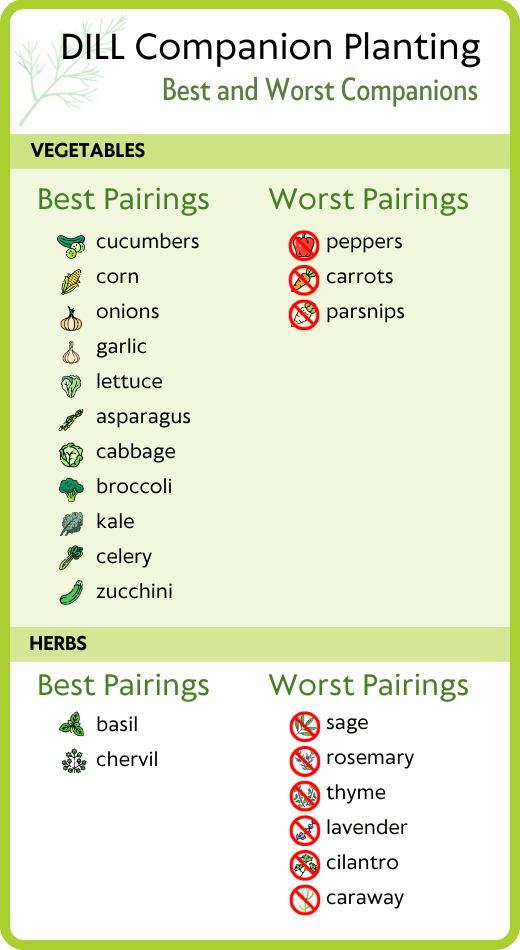
On the other hand, several vegetables and herbs make poor garden companions dill. What should not be planted with dill?
Peppers and carrots make poor vegetable companions to dill. Peppers can stunt dill’s growth, while carrots and dill can cross-pollinate. Dill should also not be planted near herbs like sage, rosemary, thyme, and lavender, as they prefer drier conditions than dill, which requires more consistent moisture.
Let’s dig deeper into dill companion planting and discover more about dill’s best and worst garden partners.
Table of Contents
Cucumbers and Dill: Great Companion Plants

Cucumbers and dill make great garden companions. Not only do they complement each other in terms of flavor, but dill also provides some excellent benefits for cucumber plants.
Purchase cucumber seed varieties from SeedsNow
Use Dill to Repel Cucumber Beetles
One advantage of planting dill alongside cucumbers is its ability to repel cucumber beetles, a common pest for cucumber crops that can cause great damage. Dill contains compounds that emit a strong scent, acting as a natural repellent for cucumber beetles. By interplanting dill, you can naturally deter these beetles without resorting to harmful pesticides.
Proper Spacing is Key
While dill can benefit cucumbers, avoiding planting them too closely together is important. Dill has a tendency to grow tall and bushy and can overshadow cucumber plants if planted nearby.
Aim for at least 18-24 inches between dill and cucumber plants. This spacing allows sufficient room for each plant to receive adequate sunlight while preventing any overshadowing issues.
Corn and Dill Grow Well Together

Dill is a natural companion to corn, attracting beneficial insects that prey on common corn pests like aphids or corn earworms.
Purchase corn seed varieties at SeedsNow
Dill Attracts Beneficial Insects to Control Corn Pests
Dill companion planting with corn can attract beneficial insects. Parasitic wasps and ladybugs are known to be attracted to dill. These insects are natural predators of common corn pests such as aphids and earworms, which can wreak havoc on a corn crop if left unchecked.
Aphids are small sap-sucking insects that can quickly multiply and damage corn plants. Ladybugs, which feed on aphids, are attracted to dill flowers and can help keep their populations in check.
Earworms are caterpillars that burrow into the ears of corn plants, causing significant damage. Dill attracts parasitic wasps, which are effective predators of these earworms.
Dill Planting Considerations
Avoid overcrowding the corn with dense clusters of dill as this could lead to competition for resources or shading issues for both plants. It’s better to intersperse individual dill plants throughout your corn patch. This allows for better air circulation while still providing enough attraction for beneficial insects.
Onions and Garlic as Dill Companions

Onions and garlic are two good companion plant choices for dill that offer numerous benefits.
Non-Competitive Growing Habits
Due to their different growing habits, onions and garlic are ideal companions for dill. While all three plants thrive in full sun and well-drained soil, they occupy different layers within the garden bed. Dill tends to grow tall and lanky, reaching heights of up to 3 feet. Onions and garlic, on the other hand, form bulbs while sending up leafy shoots.
By combining these plants together, you maximize your garden space without competition for resources like sunlight or nutrients. The vertical growth of dill allows it to coexist harmoniously with low-growing onion bulbs or garlic cloves.
Purchase onion sets and transplants from SeedsNow or Amazon
Repelling Aphids with Onions and Garlic
A key advantage of growing onions alongside dill is their ability to repel aphids, which love to feast on dill plants, causing damage and stunting their growth. The pungent aroma emitted by onions acts as a natural deterrent, keeping aphids at bay. Garlic also possesses strong scent compounds that have proven effective in repelling these unwanted pests. By interplanting dill with both onions and garlic, you create a powerful barrier against aphid infestations.
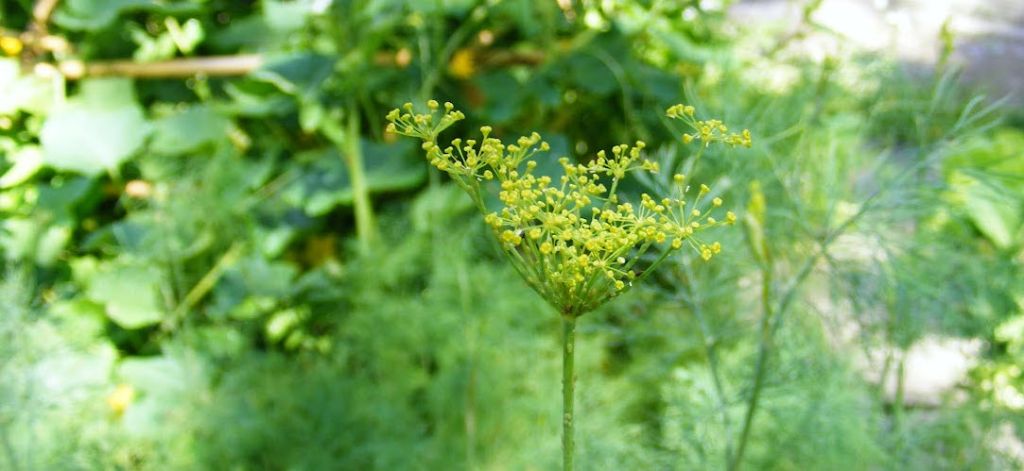
Dill Companion Planting Tips for Onion & Garlic
Dill, onions, and garlic can make good companion plants by following these strategies:
- Spacing matters: Allow sufficient space between each plant to accommodate their mature sizes.
- Rotate crops: Avoid planting dill, onions, or garlic in the same spot year after year to prevent disease buildup.
- Observe watering needs: While dill prefers moist soil, onions and garlic require less water. Strike a balance to ensure optimal growth for all plants.
Remember that companion planting is not an exact science and may require some experimentation in your specific garden conditions. However, the benefits of combining dill with onions and garlic are well worth the effort.
Lettuce and Dill

Dill is a great companion to lettuce. The tall feathery leaves of mature dill provide shade for lettuce during hot summer months, helping to prevent bolting. Dill also offers protection against common pests that can harm lettuce.
Purchase lettuce plants from Amazon or lettuce seed varieties from SeedsNow
Attracting Beneficial Insects
Dill serves as a magnet for beneficial insects like ladybugs and lacewings. These insects are natural predators of pests and play a key role in maintaining the overall health of your garden ecosystem. When you plant dill near your lettuce patch, it attracts these helpful bugs to your garden. These beneficial insects feast on aphids, larvae beetle, spider mites, and other harmful insect pests that could otherwise decimate your lettuce crop.
Asparagus and Dill

Dill’s unique characteristics make it an ideal companion for asparagus, enhancing the growth and health of both plants.
Complimentary Root Systems of Dill and Asparagus
Dill has a shallow root system that doesn’t compete with asparagus crowns. Unlike other plants with deep roots, dill’s roots stay near the surface. This allows it to grow alongside asparagus without depriving it of nutrients and stunting its growth.
Purchase asparagus crowns from SeedsNow
Dill’s Beneficial Insect Attraction
One major advantage of planting dill near asparagus is its ability to attract beneficial insects like ladybugs and lacewings. These insects prey on pests that commonly afflict asparagus crops such as aphids and mites. By attracting these helpful bugs, dill acts as a natural pest control agent.
Dill’s Shade and Sunlight Balance
Dill’s tall and airy nature complements the upright growth of asparagus. Its tall, delicate fronds provide a balance of sunlight and shade, protecting asparagus shoots from excessive sun exposure during hot summer days.
Brassicas Are Good Dill Companion Plants
Brassicas such as cabbage, broccoli, and kale are staples in many vegetable gardens. These garden plants can all benefit from companion crop planting with dill.
Cabbage and Dill

Cabbage greatly benefits from the presence of dill in the garden. Dill attracts beneficial insects like lacewings and hoverflies, which are natural enemies of cabbage worms and other pests that plague brassica plants. These helpful insects feast on the eggs and larvae of unwanted pests, keeping your cabbage patch free from destructive invaders.
Purchase cabbage seed varieties from SeedsNow
Broccoli and Dill

Broccoli is a good companion plant to dill as well. Not only does dill provide pest control properties that benefit broccoli, but it also has complementary growth habits. The delicate dill foliage allows sunlight to reach the lower parts of the broccoli plant without shading it excessively.
Purchase broccoli seed varieties from SeedsNow
Kale and Dill

Kale is another brassica plant that forms a beneficial relationship with dill. The strong aroma emitted by dill acts as a natural repellent against cabbage loopers that tend to infest kale leaves. By planting these two together, you create an environment where kale can flourish while deterring unwanted pests.
Purchase kale plants from Amazon or kale seed varieties from SeedsNow
Cole crops such as Brussels sprouts and cauliflower also make great garden companions with dill due to the benefits of this pest control relationship.
Dill and Brassicas Have Similar Growing Conditions
Brassicas and dill make great companions due to their preference for similar growing conditions. Both plants thrive in full sun and fertile soil enriched with organic matter. Their growing patterns allow them to receive adequate sunlight without overshadowing or hindering each other’s growth.
Other Vegetable Companions for Dill
Celery, zucchini, and potatoes are some other popular veggies that can benefit from the presence of dill in your garden.
Celery and Dill for Natural Pest Control

Celery is a vegetable that greatly benefits from dill companion planting, as dill attracts predatory wasps, which are natural enemies of aphids and caterpillars. These pests can cause damage to celery’s leaves and stunt its growth. By planting dill nearby, you create an inviting environment for these helpful wasps to thrive, keeping aphids and caterpillars at bay.
Purchase celery seed varieties from SeedsNow
Zucchini with Dill as a Beetle Repellent

Zucchini plants often fall victim to common beetle pests that munch away at their leaves and flowers. Dill has been found to repel squash beetles that commonly infest zucchini plants, acting as a protective measure against these garden pests.
Purchase zucchini seed varieties from SeedsNow or Amazon
Potatoes and Dill to Ward Off Harmful Insects

Potato plants are susceptible to various insect pests that can cause them damage. Planting dill near potatoes attracts beneficial insects that prey on pests such as the Colorado potato beetle. By growing dill near your potatoes, you create an environment that is less appealing to these destructive insects.
Purchase seed potatoes from SeedsNow or Amazon
Useful Herb Companions with Dill: Basil and Chervil
Basil and chervil are two excellent herb companions for dill in your garden. When planted alongside dill, these herbs provide a range of benefits.
Basil Thrives with Dill

One of the main reasons why basil thrives when planted alongside dills is their complementary growth habits. Both herbs prefer similar growing conditions, thriving in full sun and requiring moist, well-drained, fertile soil.
Basil serves as a natural pest deterrent by repelling many common garden pests like aphids, mosquitoes, and flies. By planting dill and basil together, you create an ideal environment that promotes their healthy development.
Purchase basil plants from Amazon or basil seed varieties from SeedsNow
It is important to avoid overcrowding when companion planting basil with dill. While they grow well together, it’s important not to overwhelm your dill by planting basil too closely. Give each herb enough space to flourish without competition.
Chervil: A Beneficial Companion for Dill

Chervil is an herb that pairs exceptionally well with dill in the garden, as these two herbs share similar preferences. Like dill, chervil enjoys full sun exposure but appreciates some shade during hot summer afternoons. It prefers well-drained soil enriched with organic matter to support its growth.
Purchase chervil seeds from SeedsNow
Dill and chervil both attract beneficial insects such as ladybugs, lacewings, and hoverflies. These insects feed on garden pests like aphids and caterpillars, helping to keep your vegetable garden healthy and pest-free.
Tomatoes and Dill: Friends or Foes?

Tomatoes and dill have a complex relationship. While dill helps to repel common tomato pests, it can also hinder tomato growth after it starts to bloom.
Dill as a Tomato Pest-Repellent
One significant benefit of planting dill near tomatoes is its ability to attract predators of tomato hornworms, which can be a big problem for tomato plants. Ladybugs and lacewings are among the beneficial insects attracted to dill, which feast on the hornworms and keep their population in check. By incorporating dill into your tomato patch, you may be able to reduce the damage caused by these pesky pests without resorting to harmful pesticides.
Flowering Dill Can Impede Tomato Growth
The relationship between mature dill and tomatoes can take a negative turn. Once dill reaches maturity and starts to flower, it can hinder the growth of tomato plants by damaging their roots and limiting their future development.
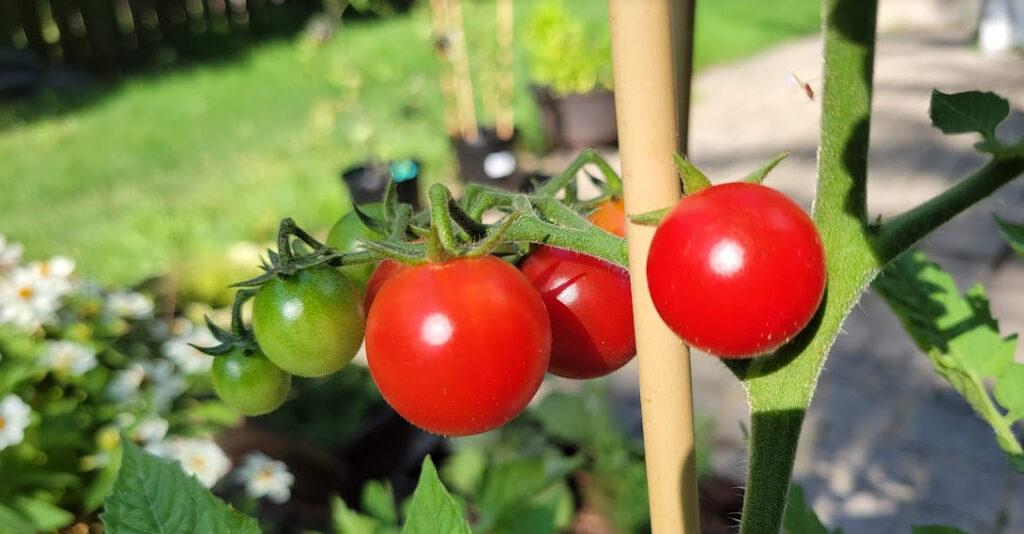
The blooming phase of dill marks the point where it becomes less compatible with tomatoes. At this stage, dill competes for essential nutrients in the soil, depriving the tomatoes of what they need to thrive and produce high-quality fruit.
Purchase tomato plants from Amazon or tomato seed varieties from SeedsNow
To maintain a beneficial companionship with tomatoes, you can prune dill regularly and prevent it to flower. This practice allows the dill to remain a supportive friend to the tomatoes in their early stages. By being proactive in managing the dill’s growth, gardeners can continue to enjoy the advantages of the early companionship between these two plants.
Bad Garden Companions: Peppers and Carrots
Peppers are Poor Dill Companions

Peppers plants and dill have incompatible characteristics that can hinder each other’s growth. Peppers possess allelopathic properties, which means they release certain compounds into the soil that inhibit the growth of neighboring plants. Dills happen to be particularly susceptible to these allelopathic effects of peppers.
The allelopathic properties of peppers can stunt the growth of dill and prevent them from reaching their full potential. To ensure successful dill companion planting, it is best to keep both bell peppers and chili peppers away from dill when planning your garden layout.
Carrot Family Vegetables and Dill Are Bad Companions

Dill is a member of the Apiaceae family, also called the Umbelliferae family, and does not grow well with other members of the family such as carrots and parsnips.
When dill reaches its flowering stage, it can cross-pollinate with other members of the carrot family nearby. Cross-pollination occurs when pollen from one plant is transferred to another plant of the same species. This process can result in undesirable characteristics in both plants involved.
Moreover, growing them close together increases the risk of disease spread between these genetically similar plants. Fungal infections or pests that affect one may easily transfer to the other if they are situated too closely. To ensure healthy growth for both crops and reduce the likelihood of disease transmission, it’s advisable to separate both carrots and parsnips from dill when planning your garden layout.
Bad Herb Companions with Dill
There are many herbs that do not grow well with dill due to their different growing requirements or competition for resources.
Dill’s Moisture Clash: Sage, Rosemary, Thyme & Lavender
Dill prefers consistent moisture and should not be grown near herbs such as sage, rosemary, thyme, and lavender, which prefer drier conditions.

Sage is known for its tolerance to drought-like conditions and should not be planted next to dill. Sage is a perennial herb that prefers drier conditions than dill, which requires far more consistent moisture over time.

Rosemary and dill are not recommended as garden companions due to their different growth requirements. Dill prefers more regular moisture than rosemary, which thrives in dry soil with minimal watering.

Thyme is a very drought-tolerant herb that should not be planted near dill, which has more substantial moisture requirements. With its preference for drier conditions, thyme is not a suitable companion plant for dill.

Lavender thrives in soil that is relatively dry, unlike dill which has a preference for regular moisture levels. Planting lavender alongside dill may result in overwatering the latter or underwatering the former, resulting in poor health for one or the other plant.
Cilantro and Dill: Cross-Pollination

Cilantro and dill are poor garden companions due to the risk of cross-pollination, as they are both members of the Apiaceae family. Cross-pollination can result in undesirable hybridization, leading to plants with compromised flavor or other undesirable characteristics. For this reason, it is not recommended to plant cilantro and dill in proximity to one another.
Caraway and Dill: Resource Rivalry

Caraway is another herb that should be kept separate from dill when planning your herb garden. Both caraway and dill compete for vital resources such as water and nutrients necessary for their growth. When planted together, this resource rivalry can lead to stunted growth for both herbs.
Conclusion
In summary, companion planting with dill can significantly enhance your garden by improving pest control and attracting beneficial insects. Spacing and understanding growing conditions are important for taking advantage of these benefits..
However, dill doesn’t pair well with all plants. Tomatoes can benefit from dill’s pest-repelling properties, but once dill flowers, it can hamper their growth. Peppers, carrots, and drought-tolerant herbs should be avoided due to moisture issues, cross-pollination, and resource competition.
Understanding and applying companion planting principles is key to creating a thriving garden. Each garden is unique, so careful observation and adjustment are paramount to success. Happy gardening!
Frequently Asked Questions (FAQs)
Can I plant dill near tomatoes?
Dill can be planted near tomatoes, but their relationship is complex. Dill benefits tomatoes by repelling pests like tomato hornworms and attracting helpful insects. However, once dill starts to bloom, it can hinder tomato growth by competing for nutrients and damaging their roots.
Can you plant dill and carrots together?
It is generally recommended to keep dill separate from carrot family vegetables like carrots, parsnips, and parsley. These plants can compete for nutrients or inhibit each other’s growth.
What are some good herb companions for dill?
Basil and chervil are good herbs to plant with dill. Both herbs thrive with dill due to their similar growth habits and shared preference for full sun and well-drained fertile soil. Chervil and dill attract beneficial insects that feed on garden pests and contribute to a pest-resistant garden when planted side by side.
Can I grow lettuce with dill?
Dill makes a good garden companion to lettuce. Dill’s feathery leaves provide shade, helping to prevent lettuce from bolting in hot weather. Dill also attracts beneficial insects like ladybugs and lacewings, helping to protect lettuce from harmful garden pests.
What herbs should not be planted with dill?
Avoid planting dill with sage, rosemary, thyme and lavender. Dill requires consistent moisture, while these herbs prefer drier conditions. Avoid planting dill with cilantro. They are in the same family and may cross-pollinate, compromising flavor. Caraway and dill are also poor companions as they compete for resources.
Last Updated on 28 April 2024 by Bob Lee
